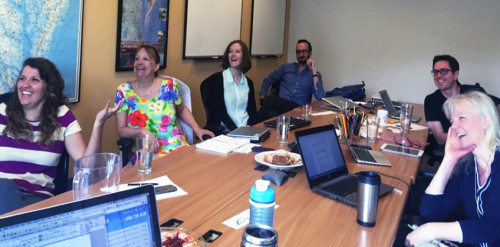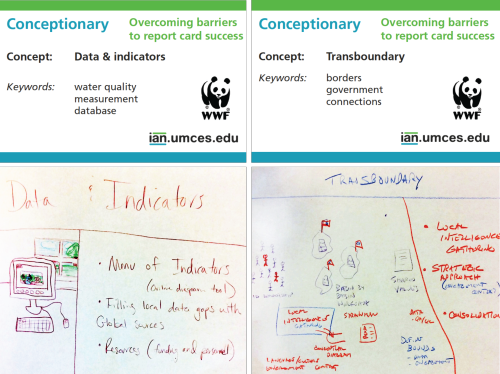Using Conceptionary to initiate discussion on barriers for implementing report cards
Bill Dennison ·This blog is part of the Basin Report Card Initiative: a partnership between the World Wildlife Fund (WWF) and the University of Maryland Center for Environmental Science (UMCES)
As part of our Integration and Application Network (IAN), University of Maryland Center for Environmental Science (UMCES) partnership with the World Wildlife Fund (WWF), we held a one day workshop on 7 May 2015 in Annapolis. The purpose of this workshop was to develop strategies to overcome barriers for implementing environmental report cards. We had identified potential barriers at our initial meeting in the Innovation Room at the WWF Washington D.C. office, described in a previous blog post. In order to catalyze a productive discussion about these previously identified barriers, we prepared for the workshop by producing a series of conceptionary cards for each of six identified barriers: Obtaining data and indicators, Maintaining process quality, Overcoming vested interests, Addressing transboundary issues, Stakeholder choice and engagement, Fostering champions and host institutions. We had identified two additional barriers, but are developing separate strategies to overcome lack of ongoing financial support and to develop an evaluation of report cards impacts.

Conceptionary is an activity that IAN regularly uses in workshops, typically to introduce the concept of conceptual diagrams. This application of Conceptionary with WWF was novel, as the successive rounds of Conceptionary were designed to stimulate discussion of a specific topic. Since we were soliciting some creative thinking focused on solving systemic and sometimes intractable problems, we felt that we needed to develop an approach that would unleash our collective creative potential, thus we turned to Conceptionary. There are several reasons we felt that Conceptionary would be a good tool for this effort. One reason is that we have found that the lateral thinking of drawing something to represent an abstract concept is a very creative process. Another reason is that Conceptionary is a game, which relaxes the participants, allowing for creative thought. And finally, the definition of the problems and establishment of key words for the Conceptionary cards provided a way to constrain and focus the discussion.
Each of the Conceptionary cards had three key words identified:
- Maintaining process quality: review, checklist, and feedback
- Obtaining data and indicators: water quality, measurement, and database
- Overcoming vested interests: ownership, inertia, and change
- Addressing transboundary issues: borders, government, and connections
- Fostering champions and host institutions: passion, knowledge, and persuasion
- Stakeholder choice and engagement: workshops, resource managers, and policy makers

After our six rounds of Conceptionary, we then broke into groups to brainstorm strategies to overcome each of the barriers. Strategies for maintaining process quality were the following: a) creating guidance materials, b) developing an outreach campaign and training program with educational materials, c) establishing a university course in creating report cards, and d) ultimately develop an accreditation and seal of approval process. Strategies for obtaining data and indicators were the following: a) assess data availability, b) choose indicators that meet criteria for sensitivity, expense, etc., c) develop an indicator review tool, and d) access global databases. Strategies for overcoming resistance and vested interests were the following: a) early engagement and transparency, b) workshops to build awareness, c) surveys for anonymous input, d) documentation of engagement, and e) web resources including discussion forum and FAQs. Strategies to address transboundary issues were the following: a) local intelligence gathering, b) strategic approach in terms of engagement, and c) consolidation of data and resources. Strategies for fostering champions and host institutions were the following: a) develop criteria for engagement, b) create demand through impact evaluations and c) effective dissemination, d) develop a strategic plan to account for existing and emerging conditions, and e) employ a systematic approach with guidelines for engagement and established criteria for engagement. Strategies for stakeholder choice and engagement were the following: a) establish principles and best practice models, b) use stakeholder mapping to identify key targeted people and groups, c) conduct basin assessments and d) work with different stakeholder personalities.

In addition to forming words for the overcoming barriers ideas, each group drew diagrams to depict these ideas to foster creative solutions and better communicate the concepts. The use of Conceptionary in this new context was rewarding and productive, as it not only stimulated a productive discussion, but it generated memorable and creative products. Conceptionary for problem solving could become a good way to address difficult problems, provided a group of motivated and creative people can be assembled.

About the author
Bill Dennison

Dr. Bill Dennison is a Professor of Marine Science and Vice President for Science Application at the University of Maryland Center for Environmental Science.